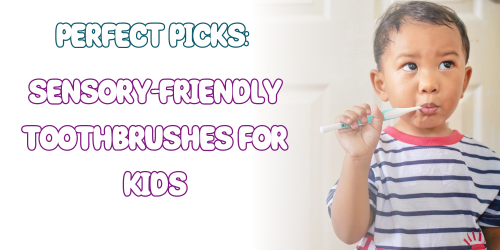How Silicone Toothbrushes Help Children with Sensory Issues
As any parent or caregiver of a child with sensory issues knows, daily routines can become significant challenges. Among these, brushing teeth is often a particularly difficult task. Traditional toothbrushes, with their stiff bristles and plastic handles, can feel abrasive and uncomfortable to children with heightened sensitivity. However, there is a game-changing solution that is making this essential daily habit more manageable and even enjoyable: silicone toothbrushes.
As any parent or caregiver of a child with sensory issues knows, daily routines can become significant challenges. Among these, brushing teeth is often a particularly difficult task. Traditional toothbrushes, with their stiff bristles and plastic handles, can feel abrasive and uncomfortable to children with heightened sensitivity. However, there is a game-changing solution that is making this essential daily habit more manageable and even enjoyable: silicone toothbrushes.
Understanding Sensory Issues
Children with sensory processing disorders experience the world differently. Their brains may overreact or underreact to sensory stimuli, causing discomfort or distress in situations that might seem ordinary to others. Oral care can be particularly problematic due to the texture and sensation of bristles on the gums and teeth, the taste of toothpaste, and the sound of brushing. These factors can turn toothbrushing into a daily battle.
Why Silicone Toothbrushes?
Silicone toothbrushes are designed with unique features that cater to the needs of children with sensory issues. Here’s how they make a difference:
1. **Gentle Bristles**:
- Silicone bristles are much softer and more flexible than traditional nylon bristles. This softness helps reduce the discomfort and pain that children with sensory issues might feel during brushing. The gentle texture of silicone is often more tolerable, making the experience less intimidating and more pleasant.
2. **Hypoallergenic and Safe**:
- Silicone is hypoallergenic and free from harmful chemicals such as BPA and phthalates. For children with allergies or sensitivities to certain materials, this is a significant benefit. Parents can feel assured that silicone toothbrushes are safe and non-toxic.
3. **Durable and Long-Lasting**:
- Silicone is a highly durable material. Unlike nylon bristles that can fray and become sharp, silicone maintains its integrity over time, providing consistent comfort and effectiveness. This durability also means that silicone toothbrushes need to be replaced less frequently.
4. **Textural Comfort**:
- The smooth, rubbery texture of silicone can be soothing to children who have aversions to the scratchy feeling of traditional bristles. The tactile sensation of silicone can even have a calming effect, making the toothbrushing routine less stressful.
5. **Easier Cleaning**:
- Silicone toothbrushes are easier to clean and maintain. They are often designed to be antibacterial, reducing the likelihood of harboring bacteria compared to traditional toothbrushes. This ensures a more hygienic brushing experience, which is crucial for children with heightened sensitivities.
6. **Versatile Designs**:
- Many silicone toothbrushes come in fun shapes and bright colors that appeal to children. Some designs even incorporate playful elements that can make brushing more engaging and enjoyable. The visual appeal can be an effective tool in encouraging reluctant brushers to participate in their oral care routine. Our bestselling Karl's U Shaped Toothbrush works fantastically with our little one!
Why Silicone Toothbrushes?
Silicone toothbrushes are designed with unique features that cater to the needs of children with sensory issues. Here’s how they make a difference:
1. **Gentle Bristles**:
- Silicone bristles are much softer and more flexible than traditional nylon bristles. This softness helps reduce the discomfort and pain that children with sensory issues might feel during brushing. The gentle texture of silicone is often more tolerable, making the experience less intimidating and more pleasant.
2. **Hypoallergenic and Safe**:
- Silicone is hypoallergenic and free from harmful chemicals such as BPA and phthalates. For children with allergies or sensitivities to certain materials, this is a significant benefit. Parents can feel assured that silicone toothbrushes are safe and non-toxic.
3. **Durable and Long-Lasting**:
- Silicone is a highly durable material. Unlike nylon bristles that can fray and become sharp, silicone maintains its integrity over time, providing consistent comfort and effectiveness. This durability also means that silicone toothbrushes need to be replaced less frequently.
4. **Textural Comfort**:
- The smooth, rubbery texture of silicone can be soothing to children who have aversions to the scratchy feeling of traditional bristles. The tactile sensation of silicone can even have a calming effect, making the toothbrushing routine less stressful.
5. **Easier Cleaning**:
- Silicone toothbrushes are easier to clean and maintain. They are often designed to be antibacterial, reducing the likelihood of harboring bacteria compared to traditional toothbrushes. This ensures a more hygienic brushing experience, which is crucial for children with heightened sensitivities.
6. **Versatile Designs**:
- Many silicone toothbrushes come in fun shapes and bright colors that appeal to children. Some designs even incorporate playful elements that can make brushing more engaging and enjoyable. The visual appeal can be an effective tool in encouraging reluctant brushers to participate in their oral care routine. Our bestselling Karl's U Shaped Toothbrush works fantastically with our little one!

Tips for Using Silicone Toothbrushes
To maximize the benefits of silicone toothbrushes, consider these tips:
- **Introduce Gradually**: Let your child explore the toothbrush at their own pace. Allow them to touch and hold it before attempting to brush.
- **Create a Routine**: Establish a consistent brushing routine. Predictability can help reduce anxiety associated with new experiences.
- **Use Positive Reinforcement**: Praise and reward your child for their efforts. Positive reinforcement can build their confidence and make them more willing to brush regularly.
- **Model Behavior**: Brush your teeth alongside your child. Demonstrating the activity can provide reassurance and encouragement.
- **Experiment with Toothpaste**: Some children with sensory issues might also be sensitive to the taste or texture of toothpaste. Experiment with different flavors and formulations to find one that your child prefers.

